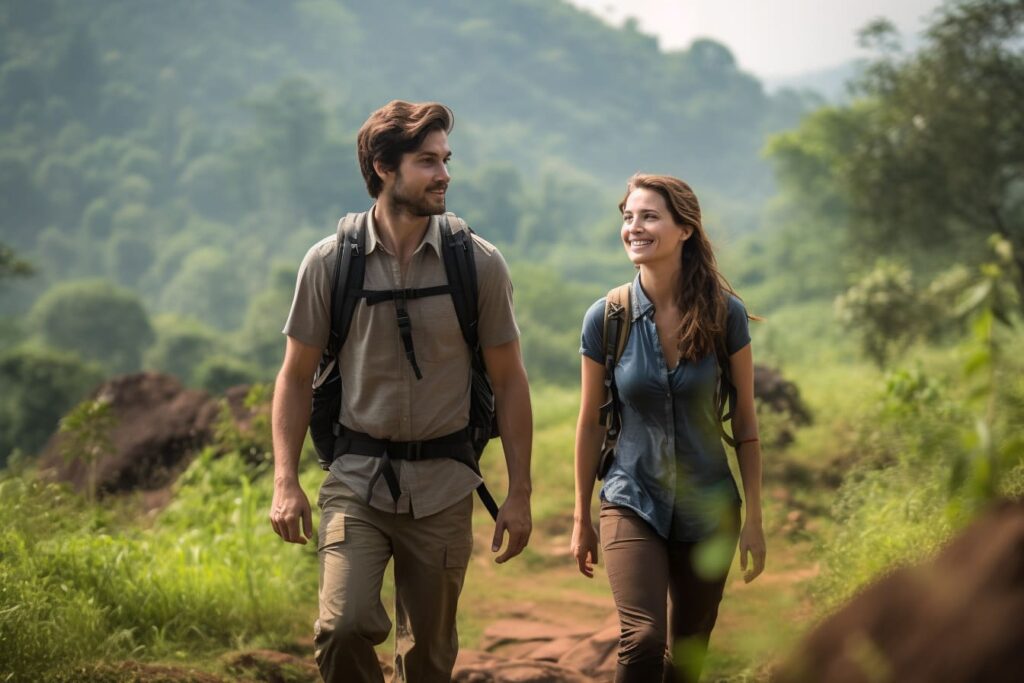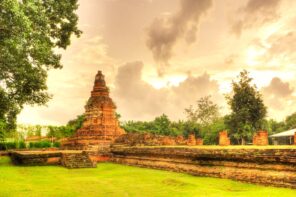Nestled in the lush, mountainous landscapes of Northern Thailand, Chiang Mai is a sanctuary for hikers and nature enthusiasts alike. Known for its breathtaking scenery, diverse ecosystems, and rich cultural heritage, this region offers some of Southeast Asia’s most rewarding hiking experiences. Whether you are an experienced trailblazer or a casual walker seeking to soak in natural beauty, Chiang Mai’s trails offer something for everyone. In this guide, we will uncover the best hiking paths, preparation tips, and how to immerse yourself fully in the natural wonders of Chiang Mai.
Why Choose Chiang Mai for Hiking?
Chiang Mai is not just a cultural hub; it’s a paradise for hikers. The region’s unique appeal lies in its stunning geographical diversity and the opportunity to experience both nature and culture in one hike. Let’s explore what makes Chiang Mai a must-visit destination for hiking enthusiasts.
Geographical Diversity
- Mountainous Terrain: Home to some of Thailand’s highest peaks, including Doi Inthanon, Chiang Mai offers challenging climbs and breathtaking vistas.
- Lush Jungles: Hikers can traverse through dense tropical forests, home to diverse flora and fauna.
- Rivers and Waterfalls: Trails often lead to serene rivers and spectacular waterfalls, offering refreshing breaks amidst nature.
Blend of Nature and Culture
- Hill Tribe Villages: Many trails wind through ethnic hill tribe villages, providing a glimpse into the lifestyles of the Hmong, Karen, and Lisu communities.
- Ancient Temples: Some hikes lead to remote temples and sacred sites, offering a spiritual dimension to your trek.
Wildlife and Flora
- Rich Biodiversity: From exotic birds to rare butterflies, the region’s wildlife adds an extra layer of excitement to your hikes.
- Flowering Plants: Depending on the season, hikers are treated to stunning displays of blooming flowers, including wild orchids.
Health and Wellness
- Clean Air: The higher elevations offer a respite from the city’s hustle and bustle, with cleaner air and a cooler climate.
- Physical and Mental Benefits: Hiking in Chiang Mai is not just a physical exercise but also a means to mental rejuvenation, surrounded by serene nature.
Chiang Mai’s trails offer a harmonious blend of natural beauty, cultural richness, and a touch of adventure. It’s a place where each step uncovers new wonders, making it a unique and fulfilling hiking destination.
Preparing for Your Hike
Embarking on a hiking adventure in Chiang Mai is an exhilarating experience, but being well-prepared is key to ensuring your hike is both enjoyable and safe. Here are some essential tips on the best times to hike, what to pack, and important safety and environmental considerations.
Best Times of Year to Hike
- Cool Season (November to February): Ideal for hiking, with cooler temperatures and minimal rainfall. The landscape is lush, and visibility is at its best.
- Hot Season (March to June): Trails can be more challenging due to the heat. If hiking during this time, start early in the morning to avoid the midday sun.
- Rainy Season (July to October): Trails can be slippery and more dangerous. However, the landscape is at its most vibrant. If hiking in this season, waterproof gear is essential.
What to Pack
- Appropriate Footwear: Durable, comfortable hiking boots or shoes with good grip.
- Lightweight Clothing: Quick-dry materials are ideal. Long sleeves and pants protect against sun and insects.
- Rain Gear: A lightweight waterproof jacket or poncho.
- Sun Protection: Sunscreen, sunglasses, and a hat or cap.
- Hydration: A refillable water bottle or hydration pack.
- Snacks: High-energy, lightweight snacks like nuts or energy bars.
- Navigation Tools: A map, compass, or a GPS device.
- First Aid Kit: Basic supplies for minor injuries.
- Insect Repellent: To protect against mosquitoes and other insects.
- Flashlight or Headlamp: Essential if you’re caught on the trail after dark.
- Camera or Smartphone: For capturing the stunning scenery (but keep usage minimal to enjoy the natural surroundings).
Safety Precautions
- Inform Someone: Let someone know your planned route and expected return time.
- Stay on Marked Trails: To reduce the risk of getting lost and to minimize your impact on the environment.
- Check Weather Forecasts: Be prepared for sudden weather changes, especially in the mountains.
- Know Your Limits: Choose a trail that matches your fitness level and experience.
Environmental Considerations
- Leave No Trace: Carry out all trash and belongings.
- Respect Wildlife: Observe animals from a distance and do not feed them.
- Sensitive Ecosystems: Stay on designated paths to protect fragile plant life.
Preparing adequately for your hike in Chiang Mai will not only enhance your enjoyment but also ensure that you contribute positively to the preservation of this beautiful region’s natural and cultural heritage.
Top Hiking Trails in Chiang Mai
Chiang Mai’s landscape is a hiker’s paradise, offering trails that cater to every level of experience and interest. Here, we explore some of the top hiking trails in the region, each offering its unique scenery and experience.

Doi Inthanon National Park
- Difficulty: Varies from easy to challenging.
- Highlights: Home to the highest peak in Thailand, this park offers a range of trails. Experience the stunning twin pagodas, cascading waterfalls, and the cloud forest near the summit.
- Scenery: Lush forests, birdwatching opportunities, and on clear days, breathtaking views across the park.
Mon Tha Than Waterfall Trail
- Difficulty: Moderate.
- Highlights: This trail is known for its series of beautiful waterfalls. It’s a relatively short hike, making it perfect for a half-day trip.
- Scenery: The path takes you through dense jungle and offers multiple spots to relax by the waterfalls.
Doi Suthep-Pui National Park
- Difficulty: Varies; trails range from gentle walks to more strenuous hikes.
- Highlights: The park is famous for the Wat Phra That Doi Suthep Temple and offers trails leading to Hmong villages. The ‘Pilgrim’s Trail’ is particularly popular.
- Scenery: Spectacular views of Chiang Mai, forested paths, and encounters with local wildlife.
The Monk’s Trail to Wat Pha Lat
- Difficulty: Easy to moderate.
- Highlights: Known as the Monk’s Trail, this path is used by monks to reach the hidden temple of Wat Pha Lat. The hike is relatively short but incredibly serene.
- Scenery: Dense jungle and the unique ‘jungle temple’ that feels like a discovery out of an adventure book.
Each of these trails offers a different perspective of Chiang Mai’s natural beauty and cultural richness. Whether you seek the thrill of reaching the highest peak, the tranquility of a hidden waterfall, the spiritual serenity of a temple, or the cultural experience of a village visit, these hikes promise rewarding experiences.
Guided Hikes vs. Solo Adventures
When planning a hike in Chiang Mai, one crucial decision is whether to embark on a guided hike or venture out on a solo adventure. Each option offers a distinct experience and suits different types of hikers. Let’s weigh the pros and cons.
Guided Hikes
Pros
- Expert Knowledge: Guides offer invaluable insights about the trails, local flora and fauna, and cultural significance of the area.
- Safety: Especially on more challenging trails, having a guide ensures that you have assistance in case of emergencies.
- Cultural Depth: Guides can provide a deeper understanding of local customs and traditions, particularly when passing through hill tribe villages.
Cons
- Cost: Guided tours can be more expensive than going solo.
- Less Flexibility: You might have to adhere to a predetermined schedule and pace.
- Group Dynamics: You’ll likely be hiking with others, which can be great for socializing but may not suit those looking for solitude.
Solo Adventures
Pros
- Flexibility: You have the freedom to choose your route, pace, and breaks.
- Personal Growth: Navigating the trails on your own can be a rewarding and empowering experience.
- Peace and Solitude: Solo hiking allows you to fully immerse yourself in nature without distractions.
Cons
- Safety Risks: Without a guide, you’re solely responsible for navigating and handling any emergencies.
- Missed Insights: You might walk past culturally or historically significant spots without realizing their importance.
- Preparation: Requires thorough planning and preparation, especially for less experienced hikers.
Choosing the Best Option
- Experience Level: If you’re a seasoned hiker, a solo trip might be more rewarding. For beginners, especially on more challenging trails, a guided hike is advisable.
- Type of Experience Desired: If you’re after cultural insights and historical context, a guided tour is preferable. For a more meditative, flexible experience, go solo.
- Safety Concerns: Assess the difficulty of the trail. In remote or complex trails, it’s safer to have a guide.
Regardless of your choice, both guided hikes and solo adventures in Chiang Mai offer memorable experiences. The key is to consider what you want out of the hike and how comfortable you feel in your hiking abilities.
Cultural Etiquette and Respect
Hiking in Chiang Mai is not just about exploring nature; it’s also an opportunity to engage with local culture and traditions. Understanding and respecting these customs is essential for a fulfilling experience. Here’s how you can show respect while hiking, especially when near temples and villages.
Respecting Local Customs
- Dress Appropriately: When near temples or religious sites, wear modest clothing that covers shoulders and knees. Remove shoes before entering temples.
- Polite Behavior: Greet locals with a smile and a “wai” (a slight bow with palms pressed together). Be mindful of your language and behavior.
- Permission for Photos: Always ask for permission before taking photos of people, especially in hill tribe villages.
Near Temples and Sacred Sites
- Observe Silence: Many of these sites are places of worship. Keep noise to a minimum.
- Respectful Conduct: Avoid touching sacred objects and statues. If sitting, never point your feet towards a Buddha image as it’s considered disrespectful.
In Villages
- Cultural Sensitivity: Be aware that you are a guest. Show respect for local ways of life and traditions.
- Economic Support: Purchasing handicrafts or snacks can be a way to support the local economy. However, be cautious about giving money directly to children as it can encourage begging.
Environmental Consideration
- Leave No Trace: Carry out all trash. Avoid picking plants or disturbing wildlife.
- Stay on Trails: Straying off the path can harm fragile ecosystems and increases the risk of getting lost.
- Water Sources: Be careful not to contaminate streams or rivers as they may be a vital water source for villagers.
Engaging with Locals
- Learn a Few Words: Knowing simple Thai phrases like “hello” (sawasdee) and “thank you” (khob khun) can go a long way in building rapport.
- Listen and Learn: If you have the opportunity to interact with locals, listen to their stories and learn from their insights.
By adhering to these etiquette and respect guidelines, hikers can ensure their adventures are not only enjoyable but also harmonious with the local environment and culture. It’s about making connections, understanding differences, and leaving a positive impact.
Wildlife and Natural Features
The trails around Chiang Mai are more than just pathways through the forest; they are gateways to some of Thailand’s most diverse ecosystems. As you hike, you’ll encounter a range of flora and fauna, some of which are rare and even endangered. Here’s an overview of what you might see and how to responsibly interact with nature.
Flora: The Green Tapestry
- Orchids and Ferns: The humid climate of Northern Thailand is perfect for a variety of orchids and ferns, some of which are unique to this region.
- Teak Trees: These towering trees are a common sight, especially in protected areas.
- Bamboo Forests: In some trails, you’ll walk through serene bamboo groves, a vital part of the local ecosystem.
Fauna: The Living Wilderness
- Birds: Chiang Mai is a haven for birdwatchers. Keep an eye out for exotic species like the Asian paradise flycatcher or the strikingly colored pheasants.
- Butterflies: The area is home to a myriad of butterflies, including the striking Blue Tiger butterfly.
- Mammals: More elusive but present are mammals like gibbons, barking deer, and even Asian elephants in more remote parts.
Rare and Endangered Species
- Asian Elephants: While sightings are rare, these magnificent creatures do inhabit some of the more remote forests in the region.
- Gibbons: Listen for their distinctive calls in the early morning. Gibbons are arboreal and mostly seen in the canopies.
Interacting with Wildlife
- Keep a Safe Distance: Always observe wildlife from a distance. Do not attempt to feed or touch any wild animals.
- Silent Observation: The quieter you are, the more likely you are to witness wildlife.
- No Flash Photography: If you’re photographing wildlife, avoid using flash as it can disturb animals.
Preserving the Environment
- Stay on Trails: This helps prevent erosion and protects undergrowth.
- No Littering: Trash can be harmful to wildlife and spoil the natural beauty.
- Respect Natural Habitats: Avoid removing any natural objects or disturbing the habitats.
Hiking in Chiang Mai offers an incredible opportunity to connect with nature. By appreciating and respecting the area’s flora and fauna, hikers can ensure these trails remain vibrant and teeming with life for future explorers.
After the Hike: Relaxing in Chiang Mai
After a day of traversing the trails around Chiang Mai, you might be looking for ways to relax and unwind. Fortunately, Chiang Mai offers an abundance of options for post-hike rejuvenation and exploration. Here are some suggestions to make the most of your time off the trail.
Indulge in Local Spas
- Traditional Thai Massage: Experience a traditional Thai massage, a perfect remedy for sore muscles after a hike.
- Herbal Steam Baths: Many local spas offer herbal steam baths, which are great for detoxifying and relaxing your body.
- Luxury Spas: For a more indulgent experience, visit one of Chiang Mai’s luxury spas where you can enjoy treatments like aromatherapy and hot stone massages.
Culinary Delights
- Northern Thai Cuisine: Explore local markets and street food stalls to taste Northern Thai specialties like Khao Soi (creamy coconut curry noodle soup) and Sai Oua (spicy sausage).
- Cooking Classes: Participate in a Thai cooking class to learn how to recreate your favorite dishes at home.
- Riverside Dining: For a more relaxed evening, dine at one of the many riverside restaurants offering beautiful views and delicious food.
Cultural Exploration
- Temple Visits: Take a peaceful evening stroll around some of Chiang Mai’s famous temples, like Wat Chedi Luang or Wat Phra Singh.
- Night Markets: Visit the bustling Night Bazaar or the Sunday Walking Street Market to shop for handicrafts, clothes, and souvenirs.
- Cultural Shows: Enjoy traditional Thai dance and music performances, often available at cultural centers or as part of dinner shows.
Outdoor Relaxation
- Hot Springs: Visit the San Kamphaeng Hot Springs or the Fang Hot Springs for a soothing dip in mineral-rich waters.
- Peaceful Parks: Spend a quiet evening at one of Chiang Mai’s parks like Suan Buak Haad City Park, where you can enjoy the serene atmosphere.
Socialize and Meet Fellow Travelers
- Backpacker Hostels and Bars: Chiang Mai’s backpacker area is a great place to meet fellow travelers and exchange stories over a drink.
- Live Music Venues: Relax at a cafe or bar offering live music, ranging from traditional Thai to modern international tunes.
After a day on the trails, Chiang Mai’s blend of relaxation, culinary experiences, and cultural activities provides the perfect way to rejuvenate. Whether you prefer a quiet evening or a night exploring the city’s vibrant scene, Chiang Mai suits every traveler’s post-hike mood.
Conclusion
In the embrace of Chiang Mai’s rolling hills and verdant landscapes, every step on the hiking trail becomes a journey through a world of natural wonders and cultural richness. The trails around Chiang Mai are not just paths through the forest, but gateways to breathtaking views, unique wildlife, and a deeper understanding of Northern Thailand’s cultural tapestry.
Hiking in this region offers more than just physical exercise; it’s an immersive experience that feeds the soul. You’ll find yourself awestruck by the panoramic views from mountain peaks, soothed by the serene sounds of nature, and humbled by the simplicity of life in the hill tribe villages. The diverse trails cater to all – from the leisurely walker seeking peace to the adventurous soul craving a challenge.
As you set out to explore these trails, remember to tread lightly, respecting both the natural environment and the local communities. Embrace the spirit of responsible tourism – leave no trace, respect the wildlife, and honor the cultural heritage of the area. By doing so, you help preserve the beauty and integrity of Chiang Mai’s hiking trails for future generations to enjoy.
Chiang Mai’s trails are waiting to tell their stories, to unveil their secrets, and to showcase their splendors. So lace up your boots, pack your spirit of adventure, and step into the heart of Northern Thailand. Whether it’s the lush greenery of the rainy season, the cool breeze of the winter, or the vibrant blooms of the summer, every season brings a new reason to fall in love with hiking around Chiang Mai.
Additional Resources
To help you plan your hiking adventures in Chiang Mai more effectively, here is a compilation of resources. From detailed trail maps to local guide services, these will equip you with the necessary information to embark on your journey.
Detailed Trail Maps
- AllTrails – Chiang Mai: AllTrails Chiang Mai offers a collection of trail maps, reviews, and photos from the hiking community.
- National Park Maps: Visit Thailand’s Department of National Parks for official maps and trail information.
Local Guide Services
- Chiang Mai Hiking: Chiang Mai Hiking specializes in guided hikes and treks in the Chiang Mai region.
- Chiang Dao Trekking: Chiang Dao Trekking offers guided tours with a focus on cultural and environmental awareness.
Further Reading
- Lonely Planet – Hiking in Chiang Mai: The Lonely Planet guide provides insights and tips for trekking in and around Chiang Mai. Lonely Planet Guide
- TripAdvisor – Chiang Mai Hiking Trails: For traveler reviews and tips on the best hiking trails in Chiang Mai, visit TripAdvisor.
Mobile Apps
- Maps.Me: This app offers detailed offline maps which are helpful for navigation on the trails.
- Trail Wallet: Keep track of your travel expenses with this easy-to-use budgeting app.
Books
- “Trekking in Thailand” by David Smyth: A comprehensive guidebook covering a range of treks in Thailand, including in the Chiang Mai region.
- “Birds of Thailand” by Michael Webster and Chew Yen Fook: Perfect for birdwatchers, this field guide is a great companion for identifying local species.
These resources will provide you with a wealth of information to make your hiking experience in Chiang Mai as rewarding and enjoyable as possible. Remember, good preparation is key to a successful and memorable hiking trip.





